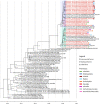Highly Pathogenic Avian Influenza H5N8 in Poland in 2019-2020
- PMID: 33367134
- PMCID: PMC7734677
- DOI: 10.2478/jvetres-2020-0078
Highly Pathogenic Avian Influenza H5N8 in Poland in 2019-2020
Abstract
Introduction: Repeated incursions of highly pathogenic avian influenza virus (HPAIV) H5 subtype of Gs/GD lineage pose a serious threat to poultry worldwide. We provide a detailed analysis of the spatio-temporal spread and genetic characteristics of HPAIV Gs/GD H5N8 from the 2019/20 epidemic in Poland.
Material and methods: Samples from poultry and free-living birds were tested by real-time RT-PCR. Whole genome sequences from 24 (out of 35) outbreaks were generated and genetic relatedness was established. The clinical status of birds and possible pathways of spread were analysed based on the information provided by veterinary inspections combined with the results of phylogenetic studies.
Results: Between 31 December 2019 and 31 March 2020, 35 outbreaks in commercial and backyard poultry holdings and 1 case in a wild bird were confirmed in nine provinces of Poland. Most of the outbreaks were detected in meat turkeys and ducks. All characterised viruses were closely related and belonged to a previously unrecognised genotype of HPAIV H5N8 clade 2.3.4.4b. Wild birds and human activity were identified as the major modes of HPAIV spread.
Conclusion: The unprecedentedly late introduction of the HPAI virus urges for re-evaluation of current risk assessments. Continuous vigilance, strengthening biosecurity and intensifying surveillance in wild birds are needed to better manage the risk of HPAI occurrence in the future.
Keywords: H5N8; epidemic; highly pathogenic avian influenza.
© 2020 K. Śmietanka et al. published by Sciendo.
Conflict of interest statement
Conflict of Interest Conflict of Interests Statement: The authors declare that there is no conflict of interests regarding the publication of this article.
Figures


Similar articles
-
Multiple Introductions of Reassorted Highly Pathogenic Avian Influenza H5Nx Viruses Clade 2.3.4.4b Causing Outbreaks in Wild Birds and Poultry in The Netherlands, 2020-2021.Microbiol Spectr. 2022 Apr 27;10(2):e0249921. doi: 10.1128/spectrum.02499-21. Epub 2022 Mar 14. Microbiol Spectr. 2022. PMID: 35286149 Free PMC article.
-
The genetics of highly pathogenic avian influenza viruses of subtype H5 in Germany, 2006-2020.Transbound Emerg Dis. 2021 May;68(3):1136-1150. doi: 10.1111/tbed.13843. Epub 2020 Sep 29. Transbound Emerg Dis. 2021. PMID: 32964686 Review.
-
Phylogenetic Analysis of H5N8 Highly Pathogenic Avian Influenza Viruses in Ukraine, 2016-2017.Vector Borne Zoonotic Dis. 2021 Dec;21(12):979-988. doi: 10.1089/vbz.2021.0031. Vector Borne Zoonotic Dis. 2021. PMID: 34958264 Free PMC article.
-
Respiratory disease due to mixed viral infections in poultry flocks in Egypt between 2017 and 2018: Upsurge of highly pathogenic avian influenza virus subtype H5N8 since 2018.Transbound Emerg Dis. 2021 Jan;68(1):21-36. doi: 10.1111/tbed.13281. Epub 2019 Jul 11. Transbound Emerg Dis. 2021. PMID: 31297991
-
Global review of the H5N8 avian influenza virus subtype.Front Microbiol. 2023 Jun 2;14:1200681. doi: 10.3389/fmicb.2023.1200681. eCollection 2023. Front Microbiol. 2023. PMID: 37333639 Free PMC article. Review.
Cited by
-
Avian influenza overview December 2020 - February 2021.EFSA J. 2021 Mar 3;19(3):e06497. doi: 10.2903/j.efsa.2021.6497. eCollection 2021 Mar. EFSA J. 2021. PMID: 33717356 Free PMC article.
-
Genotype Diversity, Wild Bird-to-Poultry Transmissions, and Farm-to-Farm Carryover during the Spread of the Highly Pathogenic Avian Influenza H5N1 in the Czech Republic in 2021/2022.Viruses. 2023 Jan 20;15(2):293. doi: 10.3390/v15020293. Viruses. 2023. PMID: 36851507 Free PMC article.
-
Multiple Introductions of Reassorted Highly Pathogenic Avian Influenza H5Nx Viruses Clade 2.3.4.4b Causing Outbreaks in Wild Birds and Poultry in The Netherlands, 2020-2021.Microbiol Spectr. 2022 Apr 27;10(2):e0249921. doi: 10.1128/spectrum.02499-21. Epub 2022 Mar 14. Microbiol Spectr. 2022. PMID: 35286149 Free PMC article.
-
Dynamics of a Panzootic: Genomic Insights, Host Range, and Epidemiology of the Highly Pathogenic Avian Influenza A(H5N1) Clade 2.3.4.4b in the United States.Viruses. 2025 Feb 25;17(3):312. doi: 10.3390/v17030312. Viruses. 2025. PMID: 40143242 Free PMC article. Review.
-
The Role of Airborne Particles in the Epidemiology of Clade 2.3.4.4b H5N1 High Pathogenicity Avian Influenza Virus in Commercial Poultry Production Units.Viruses. 2023 Apr 19;15(4):1002. doi: 10.3390/v15041002. Viruses. 2023. PMID: 37112981 Free PMC article.
References
-
- Alarcon P., Brouwer A., Venkatesh D., Duncan D., Dovas C.I., Georgiades G., Monne I., Fusaro A., Dan A., Śmietanka K., Ragias V., Breed A.C., Chassalevris T., Goujgoulova G., Hjulsager C.K., Ryan E., Sánchez A., Niqueux E., Tammiranta N., Zohari S., Stroud D.A., Savić V., Lewis N.S., Brown I.H.. Comparison of 2016-17 and previous epizootics of highly pathogenic avian influenza H5 Guangdong lineage in Europe. Emerg Infect Dis. 2018;24:2270–2283. - PMC - PubMed
-
- Alexander D. J.. An overview of the epidemiology of avian influenza. Vaccine. 2007;25:5637–5644. - PubMed
-
- Bodewes R., Kuiken T.. Changing role of wild birds in the epidemiology of avian influenza A viruses. Adv Virus Res. 2018;100:279–307. - PubMed
-
- Capua I., Alexander D. J.. Avian influenza infection in birds: A challenge and opportunity for the poultry veterinarian. Poultry Sci. 2009;88:842–846. - PubMed
LinkOut - more resources
Full Text Sources
